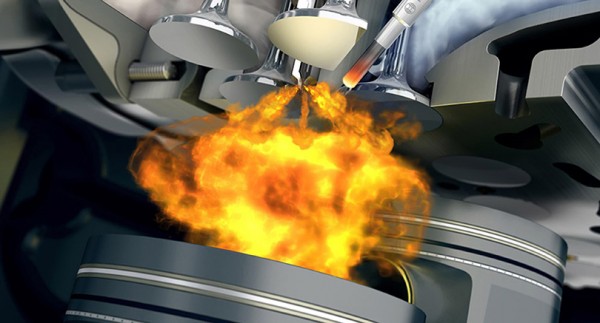For the past 150 years or so,
the combustion engine has ruled the world. In a quest to save the planet, governments across the globe are scheming to dethrone it by force. Some countries are even planning to ban fossil-fuel cars entirely within the next ten years. Are the curtains really about to close on one of mankind’s greatest inventions?
Even when I was just a young boy, which is quite a while ago by now, I would flip through car magazines and come across the odd electrical car. Usually a futuristic concept design of some kind, but still. The idea of propelling cars forward by electric motors isn’t exactly new, it’s rather ancient in fact, but it’s fair to say that their use in regular production cars is relatively new. When Toyota made the first mass produced hybrid electric car, the Prius, it was big news. Hard to believe that was almost 20 years ago already. In the present, Tesla Motors is making waves and creating a buzz with fully electric vehicles which are not only green (ish) but also properly fast and reasonably stylish to boot.
The first wave of hybrid hypercars hit the mark, too. The McLaren P1, Ferrari LaFerrari and Porsche 918 Spyder all had batteries and electric motors inside them. Alongside a hugely powerful internal combustion engine, obviously, but it was probably the clearest sign yet that the times really are changing. Still, all is not lost for those of us who quite enjoy being propelled forwards by the controlled explosion of ancient algae and plankton. Petroleum based fuels may be on a downhill slope for very good reasons, but the technology to phase them out completely does not yet exist.
![]()
Let’s look at Tesla, brain child of the wildly enthusiastic visionary Elon Musk. He appears to be the type of guy who jumps out of a plane first, and only then turns his mind to the task of figuring out how to deploy the parachute. At the very least, his approach does ensure sufficient motivation exists to succeed. A vast R&D budget has meant that Tesla as a company has been mind-bogglingly unprofitable thus far. But at the same time they have truly changed the game, and made the established car manufacturers look a bit old and slow in the process. If there are still history text books on technical progress in a hundred years’ time, I’m pretty confident Elon Musk will have an entire chapter devoted to him. How happy his investors will turn out to be, however, remains an unanswered question at this point.
![]()
Elon Musk, CEO and Co-founder of Tesla Motors
The high risk approach adopted by Tesla has proven beyond doubt that the concept of fully electric cars can work. At the same time, they’ve also proven that the technology simply isn’t ready to replace conventional cars yet. In the present, they still only really work if you don’t need to drive too far. What the world is really waiting for is a genuine breakthrough in battery technology that increases the power density by an order of magnitude. You can read about promising new battery chemistries every month or so, but thus far none of them have turned out to be viable for mass production. The wait continues. Right now, a Tesla car’s battery pack basically consists of a huge amount of laptop-type batteries connected together in various ways. Not exactly ground breaking.
![]()
A Tesla car’s battery pack and individual battery
There’s also, as always, the fog of marketing. For example, Tesla has this hugely innovative feature called «autopilot». You’ve probably heard of it, basically it means the car is driving itself. But it only works in a narrow set of conditions (like a highway) and the driver needs to stay alert and keep his hands on the wheel at all times to minimize the risk of dying in a fiery accident when the software makes a mistake. That’s a lot to ask from the average human once he gets used to just putting the car on «autopilot» every morning on his highway commute. The first deadly accident with a Tesla on autopilot made the headlines, perhaps unfairly so from a statistical point of view. But the catchy name of Tesla’s autopilot increases people’s misperception of what it ought to be doing versus what it actually does. It’s really a driver laziness assist rather than a fully autonomous system capable of taking over driving duties completely.
Of course, that having been said, I remain convinced that even a very flawed autopilot is still a better driver than many people who posess driving licenses. The autopilot will not be sending text messages while it’s driving, nor will it comb its hair or read a newspaper. It’s just good to keep in mind that, when you enable the autopilot, you’re putting your life in the hands of an unfinished ,»work in progress«, piece of software. Tesla seems comfortable with giving its customers the task of beta testing new features. I think that may be putting a bit too much faith in humanity, but who am I to judge.
Perhaps the most noticeable way in which Tesla has upset the automotive apple cart, has been the performance of its cars. In particular, acceleration from a dead stop. It makes for a pretty entertaining YouTube video when your large and comfy electric car beats a Lamborghini in a drag race without breaking a sweat. It’s possible because electric motors are extremely suitable to accelerate a vehicle from a stop. They can create maximum torque from zero RPM whereas a conventional engine simply can’t deliver power without building considerable RPMs. Just how fast a Tesla will go depends solely on how many volts and amps are available to send to the motors. The latest Tesla model S, with the largest battery and dual motors for all-wheel drive, can reach 100 km/h in as little as two and a half seconds. They are, quite literally, ludicrously fast. Extra points to Tesla for naming its super acceleration setting «ludicrous mode» after the cult movie «Spaceballs» which was basically a Star Wars parody by Mel Brooks. And well worth watching too, if you haven’t seen it yet.
![]()
Either way, Teslas are very fast machines. Just how fast depends on the battery charge however. You’ll only be able to reach the fastest acceleration time when the batteries are full. The performance basically goes downhill as soon as the battery starts to drain. They batteries and motors also cannot sustain the stunning acceleration for very long as they start to heat up very quickly. It lasts long enough for a 0-100 km/h sprint or even a quarter mile drag race, but not much longer than that. So there are many, many applications where you still need a regular old engine. I know such a thing as hydrogen fuel cells exist as well, but they are even further behind than batteries. Hydrogen fuel cell technology still requires the use of very expensive rare metals, and setting up a network of hydrogen refueling stations is the stuff of nightmares. The fact that hydrogen loves nothing more than to go boom is a bit disconcerting as well.
Which brings us back to hybrids. Many people see hybrid cars as a sort of temporary step while we evolve from using petroleum based fuels to purely electric, but I think that’s not entirely fair. Hybrid electric cars really do offer the best of both worlds in many ways. They have unlimited driving range, for a start. As long as there are fuel stations, you can keep going. They also get to use the benefit of electric motors which can be used to «fill in» the gaps in performance that a combustion engine has in terms of low RPM torque or turbo lag. And they don’t need to carry too many batteries around to make it all happen, which saves weight. Most important of all: they already work really well in the real world. And I feel it will be a very long time, if it ever happens, that fully electric cars become better overall than what hybrids are already offering right now.
![]()
The BMW i8 is a great example of what sporty hybrid cars can be like
Purely by chance, I recently drove a hybrid rental car for a few days. Being a rental Toyota hybrid, I can’t say it was the most exhilarating driving of my life. But it gave me some time to appreciate just how well it works. Using batteries to store recovered energy that would normally be lost by braking, and then deploying that with an electric motor to either save fuel or make the car go faster is an elegant and efficient concept with very few downsides. Energy recovery is a big part of the future, and as modern Formula 1 cars are showing, the results can be very impressive. Getting rid of the internal combustion engine altogether is simply a step too far. It’s to throw the baby out with the bathwater. Until we find a magical way to create batteries that are far more energy dense and ecologically friendly to produce, and generating the electricity in clean power stations, hybrids are overall superior to fully electric cars.
It’s true that we, as enthusiasts, got off somewhat on the wrong foot with hybrid cars. The Prius wasn’t exactly an inspiration, nor were all the Hollywood celebrities who suddenly had to have one and tell us all about it. But that’s all water under the bridge. All was forgiven once we got the 918 Spyder, LaFerrari and P1. The BMW i8 gave us a slightly more affordable twist on a hybrid sports car, now it’s about time for performance hybrids to become mainstream. For the internal combustion engine, the 21st century may still be a good one.
![]()











